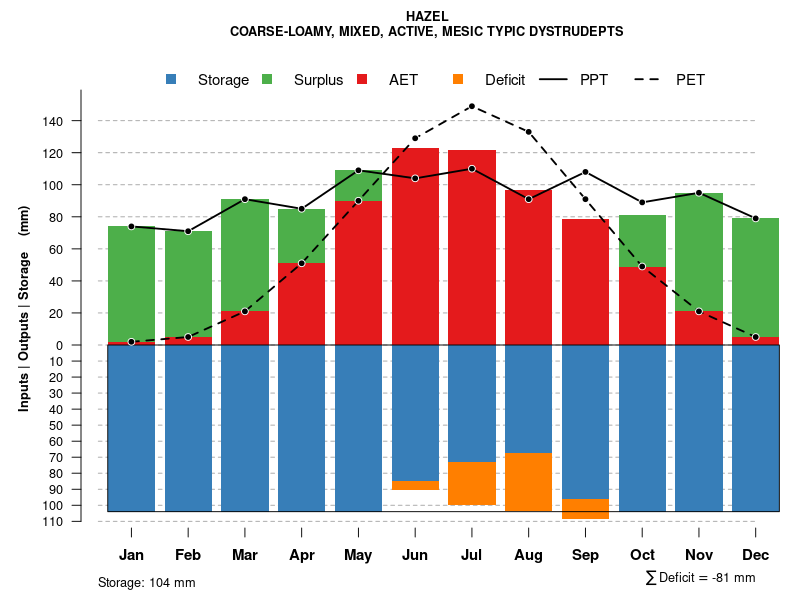| Weverton-Hazel complex, 15 to 25 percent slopes, very stony | WeD | 2439 | 535094 | kyt3 | md021 | 2001 | 1:12000 |
Weverton-Hazel complex, 8 to 15 percent slopes, very stony | WeC | 1885 | 535093 | kyt2 | md021 | 2001 | 1:12000 |
Weverton-Hazel complex, 25 to 45 percent slopes, very stony | WeE | 1810 | 535095 | kyt4 | md021 | 2001 | 1:12000 |
Hazel channery silt loam, 8 to 15 percent slopes | HnC | 1591 | 534420 | ky3c | md043 | 1998 | 1:12000 |
Hazel channery silt loam, 15 to 25 percent slopes | HnD | 1092 | 534423 | ky3g | md043 | 1998 | 1:12000 |
Hazel-Rock outcrop complex, 25 to 45 percent slopes | HrE | 1030 | 534439 | ky3z | md043 | 1998 | 1:12000 |
Hazel channery silt loam, 3 to 8 percent slopes | HnB | 797 | 534418 | ky39 | md043 | 1998 | 1:12000 |
Hazel loam, 15 to 25 percent slopes | 39D | 4550 | 516370 | kbb3 | va003 | 1981 | 1:15840 |
Hazel loam, 25 to 45 percent slopes | 39E | 4530 | 516371 | 2yfh2 | va003 | 1981 | 1:15840 |
Hazel loam, 25 to 45 percent slopes, very stony | 40E | 3710 | 516376 | 2xxy9 | va003 | 1981 | 1:15840 |
Hazel loam, 15 to 25 percent slopes, very stony | 40D | 910 | 516375 | 2xxy8 | va003 | 1981 | 1:15840 |
Hazel loam, 7 to 15 percent slopes | 39C | 770 | 516369 | kbb2 | va003 | 1981 | 1:15840 |
Hazel complex, steep | HnE | 4690 | 519229 | kf9b | va035 | 1965 | 1:15840 |
Hazel channery complex, steep | HmE | 2536 | 519226 | kf97 | va035 | 1965 | 1:15840 |
Hazel channery complex, very steep | HmF | 1461 | 519227 | kf98 | va035 | 1965 | 1:15840 |
Hazel complex, sloping | HnC | 1028 | 519228 | kf99 | va035 | 1965 | 1:15840 |
Hazel sandy loam, 15 to 25 percent slopes, rocky | 25D | 6789 | 1895276 | 21m5y | va061 | 2006 | 1:12000 |
Hazel-Edgemont complex, 7 to 15 percent slopes, rocky | 25C | 4831 | 1895275 | 21m5x | va061 | 2006 | 1:12000 |
Hazel sandy loam, 25 to 45 percent slopes, very stony | 125E | 2246 | 1895421 | 21mbm | va061 | 2006 | 1:12000 |
Hazel sandy loam, 15 to 25 percent slopes, very stony | 125D | 1596 | 1895420 | 21mbl | va061 | 2006 | 1:12000 |
Hazel sandy loam, 7 to 15 percent slopes, very stony | 125C | 332 | 1895419 | 21mbk | va061 | 2006 | 1:12000 |
Hazel sandy loam, 25 to 45 percent slopes, rocky | 25E | 326 | 1895277 | 21m5z | va061 | 2006 | 1:12000 |
Hazel-Rock outcrop complex, 25 to 45 percent slopes | 225E | 215 | 1895434 | 21mc1 | va061 | 2006 | 1:12000 |
Hazel-Rock outcrop complex, 15 to 25 percent slopes | 225D | 164 | 1895433 | 21mc0 | va061 | 2006 | 1:12000 |
Hazel loam, 15 to 25 percent slopes | HzD | 1135 | 516895 | kbw1 | va079 | 1983 | 1:15840 |
Hazel loam, 25 to 45 percent slopes | HzE | 313 | 516896 | kbw2 | va079 | 1983 | 1:15840 |
Hazel loam, 15 to 25 percent slopes | HaD | 6661 | 517002 | kbzh | va113 | 1967 | 1:15840 |
Hazel loam, 25 to 55 percent slopes | HaF | 2985 | 517003 | kbzj | va113 | 1967 | 1:15840 |
Hazel loam, 7 to 15 percent slopes | HaC | 1208 | 517001 | kbzg | va113 | 1967 | 1:15840 |
Hazel channery loam, 25 to 50 percent slopes | 25E | 9901 | 136971 | 4ljf | va125 | 1992 | 1:24000 |
Hazel loam, 25 to 50 percent slopes, very stony | 26E | 4043 | 136978 | 4ljn | va125 | 1992 | 1:24000 |
Hazel channery loam, 15 to 25 percent slopes | 25D | 1601 | 136970 | 4ljd | va125 | 1992 | 1:24000 |
Hazel loam, 15 to 25 percent slopes, very stony | 26D | 752 | 136976 | 4ljl | va125 | 1992 | 1:24000 |
Hazel channery loam, 7 to 15 percent slopes | 25C | 217 | 136969 | 4ljc | va125 | 1992 | 1:24000 |
Hazel loam, 7 to 15 percent slopes | HaC | 1092 | 119844 | 40py | va137 | 1966 | 1:15840 |
Hazel loam, 15 to 30 percent slopes | HaD | 834 | 119845 | 40pz | va137 | 1966 | 1:15840 |
Hazel loam, moderately steep phase | HeD | 2357 | 517437 | kcfj | va157 | 1958 | 1:20000 |
Hazel loam, sloping phase | HeC | 1135 | 517436 | kcfh | va157 | 1958 | 1:20000 |
Hazel loam, steep phase | HeE | 722 | 517438 | kcfk | va157 | 1958 | 1:20000 |
Hazel stony loam, steep phase | HsE | 641 | 517440 | kcfm | va157 | 1958 | 1:20000 |
Hazel stony loam, moderately steep phase | HsD | 416 | 517439 | kcfl | va157 | 1958 | 1:20000 |
Hazel - Urban land complex, 15 to 25 percent slopes | 139D | 17 | 2514316 | 2qjgy | va540 | 2011 | 1:24000 |
Hazel loam, 15 to 25 percent slopes | 39D | 6 | 2496439 | kbb3 | va540 | 2011 | 1:24000 |
Hazel loam, 25 to 45 percent slopes | 39E | 6 | 2496457 | 2yfh2 | va540 | 2011 | 1:24000 |













